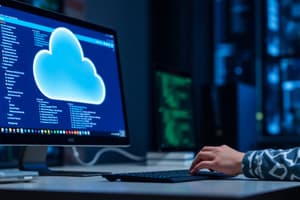Podcast
Questions and Answers
Which aspect of End-User Computing (EUC) empowers individuals without programming backgrounds?
Which aspect of End-User Computing (EUC) empowers individuals without programming backgrounds?
- Enabling them to develop applications and outputs. (correct)
- Limiting their interaction with computing systems.
- Restricting their access to advanced software.
- Forcing them to rely solely on IT professionals.
What is the key aim of end-user computing?
What is the key aim of end-user computing?
- To ensure all computing tasks require the involvement of professional programmers.
- To centralize all computing processes under a single IT department.
- To allow end-users more control over their computing environment, reducing reliance on programmers. (correct)
- To limit end-users' control over their computing environment.
Which of the following is an example of a mobile, web, and cloud application within End-User Computing (EUC)?
Which of the following is an example of a mobile, web, and cloud application within End-User Computing (EUC)?
- A customized laptop.
- Instant messaging. (correct)
- Desktop operating system.
- System administrator tools.
How does End-User Development (EUD) enhance the application development process?
How does End-User Development (EUD) enhance the application development process?
What is one of the key advantages of involving end-users in application development?
What is one of the key advantages of involving end-users in application development?
What is a potential risk associated with End-User Computing (EUC)?
What is a potential risk associated with End-User Computing (EUC)?
Which of the following represents a security risk associated with End-User Computing (EUC)?
Which of the following represents a security risk associated with End-User Computing (EUC)?
What is a key characteristic of application packages as End-User Computing (EUC) tools?
What is a key characteristic of application packages as End-User Computing (EUC) tools?
Which type of programming language allows end-users to develop computing solutions and consolidate them into an information system?
Which type of programming language allows end-users to develop computing solutions and consolidate them into an information system?
What is the primary goal of office automation?
What is the primary goal of office automation?
Which capability is commonly provided by electronic spreadsheet software?
Which capability is commonly provided by electronic spreadsheet software?
Which functionality is typically associated with project management software?
Which functionality is typically associated with project management software?
What characterizes internal, downward telecommunication within a business?
What characterizes internal, downward telecommunication within a business?
Which network topology allows any member to communicate with all other members, fostering high participation and collaboration?
Which network topology allows any member to communicate with all other members, fostering high participation and collaboration?
What is a primary benefit of utilizing e-business systems?
What is a primary benefit of utilizing e-business systems?
What role does 'reintermediation' play in customer-centered retailing within e-business?
What role does 'reintermediation' play in customer-centered retailing within e-business?
Which activity is central to the function of a Transaction Processing System (TPS)?
Which activity is central to the function of a Transaction Processing System (TPS)?
What is the meaning of the term 'Data Capture' in the context of Transaction Processing Systems (TPS)?
What is the meaning of the term 'Data Capture' in the context of Transaction Processing Systems (TPS)?
What is the purpose of 'Data Validation' in a Transaction Processing System (TPS)?
What is the purpose of 'Data Validation' in a Transaction Processing System (TPS)?
What is a key advantage of using an Operational Information System?
What is a key advantage of using an Operational Information System?
Flashcards
End-User Computing (EUC)
End-User Computing (EUC)
Computer systems and platforms enabling non-programmers to create applications and outputs.
End-User Development (EUD)
End-User Development (EUD)
Development of information systems by end-users, often with IT support.
Application Packages
Application Packages
Pre-written software marketed commercially for standard business functions.
Fourth-Generation Programming Languages
Fourth-Generation Programming Languages
Programming languages allowing end-users to develop and consolidate computing solutions.
Signup and view all the flashcards
Office Automation
Office Automation
Complete integration of basic office requirements for a department.
Signup and view all the flashcards
Office Information System (OIS)
Office Information System (OIS)
Information system improving workflow and communication of office workers.
Signup and view all the flashcards
Software Packages (in Office Automation)
Software Packages (in Office Automation)
Bundled applications interacting with system resources.
Signup and view all the flashcards
Telecommunication
Telecommunication
Sharing information over a distance using electronic or digital means.
Signup and view all the flashcards
Internal, Downward Communication
Internal, Downward Communication
Information circulates top-down within a business/organization.
Signup and view all the flashcards
Internal, Upward Communication
Internal, Upward Communication
Subordinates send info up the hierarchy to managerial/executive levels.
Signup and view all the flashcards
Internal, Lateral Communication
Internal, Lateral Communication
Telecommunication between co-workers or co-members across departments.
Signup and view all the flashcards
External Communication
External Communication
Telecommunication that deals with external entities like customers or vendors.
Signup and view all the flashcards
Telecommunication Networking
Telecommunication Networking
Connectivity of a business to streamline processes and tasks.
Signup and view all the flashcards
Wheel Network
Wheel Network
One member is allowed to send or receive communication.
Signup and view all the flashcards
Chain Network
Chain Network
Members communicate in a set sequence, following an org structure.
Signup and view all the flashcards
Circle Network
Circle Network
Hierarchy with comms between superiors/subordinates & cross-communication.
Signup and view all the flashcards
Star/All-Channel Network
Star/All-Channel Network
Each member communicates with all members facilitating high participation.
Signup and view all the flashcards
E-Business
E-Business
Organizational system applying electronical technologies to business activities.
Signup and view all the flashcards
E-Commerce Support Systems
E-Commerce Support Systems
Backend services offered from other enterprises payment, credit, etc; applications.
Signup and view all the flashcards
Transaction Processing System (TPS)
Transaction Processing System (TPS)
Systems documenting company and resulting data for operational business.
Signup and view all the flashcardsStudy Notes
End-User Computing (EUC)
- Computer systems and platforms allow non-programmers (end-users) to create working applications and outputs
- EUC helps end-users control their computing environment without programmers.
- Encompasses all computer uses by end-users for whom programmers develop.
Types of EUC
- Desktop and Laptop Computers: Common hardware aspect of an EUC solution, customizable for end-user specifications.
- Desktop Operating Systems and Applications: Software aspect, packaged with an OS or sold/developed separately
- Examples include Windows System and Administrator Tools and Application Suites like Microsoft Office and Adobe Master Collection.
- Smartphones and Wearables: Focuses on mobile hardware platforms and usable software (apps/widgets).
- Mobile, Web, and Cloud Applications: Prioritizes mobility and connectivity, offered as a service
- Examples include e-mail, instant messaging, and cloud storage.
- Virtual Desktops and Application: Enhances mobility and connectivity via online, cloud-based computing "as-a-service."
- Eliminates hardware/software specifications, popularizing BYOD
- Examples include virtual workplace suites like Microsoft Office 365.
End-User Development (EUD)
- EUD is the practice where end-users develop their own information systems, supported by IT professionals.
- End-users get access to computing facilities, networks, Internet, data access, and training.
Benefits of End-User Computing
- Enhances productivity for professional and white-collar workers.
- Empowers end-users to create information system solutions, developing new skills.
- Reduces/Eliminates business process steps by revising or eliminating steps to make processes easier and more effective.
- Overcomes DP shortages by equipping end-users with software training tools.
- Provides user-friendly and responsive systems due to direct end-user involvement.
- System implementations are improved by transferring the process to the user.
Risks of End-User Computing
- Errors in analysis are possible, as poorly trained end-users may incorrectly analyze data or systems.
- Lack of documentation is a risk, as most end-users aren't trained in analysis and design.
- Faulty Models can occur if Decision Support Systems rely on end-user-developed corporate models in spreadsheets.
- Security/Piracy issues can arise because end-user software may lack security measures.
End-User Computing Tools
- Application Packages: Pre-written, commercially marketed software that supports standard business functions
- Examples include payroll, ledgers, and inventory control with Microsoft Office Suite.
- Fourth-Generation Programming Languages: Allow end-users to develop and consolidate computing solutions.
- Example is SQL for managing databases.
End-User Systems Tools
- Text and Multimedia Handling Tools: Word processing, desktop publishing, presentation software, and document management.
- Data Handling Tools: Spreadsheets, statistical packages, decision support systems, and databases.
- Communication Tools: E-mail, VoIP, fax, and pagers.
- Office Automation Tools: Diary management, electronic notebooks, project management, PDAs, and Bluetooth.
- Group Systems / Computer Supported Collaborative Work: Teleconferencing and virtual workspaces.
- Graphic Design: Graphic software and computer-aided design.
- Knowledge Management: Expert systems, data mining, and information retrieval.
Office Automation
- Complete integration of basic office requirements within an organization to avoid duplicated effort or resources
- Includes word processing, electronic data filing, diary management, and communications.
Office Information System (OIS)
- Uses software, hardware, and networking to improve workflow/communication
- Supports business office activities for management and workforce efficiency.
- Systems evolve and automate, increasing their flexibility and effectiveness.
- Facilitates electronic communication via e-mail and instant messaging.
- Manages audio-video communication via telephony/teleconference or prompt directory systems.
- Facilitates record management via databases and/or data servers.
- Automates business-specific processes, reducing manpower.
- Provides EUC to enhance end-user efficiency.
Applications of Office Automation
- Functions: Operations activated by function keys/sequences
- Examples: Cut, Copy, Delete, Move, Search, Calculate, Change Font, and Print.
- Software Packages: Bundled applications that interact with system resources
- Functionality includes textual document production, spreadsheets, and data presentation
- Examples include Microsoft Office Suite and Google Docs.
- Process Software: Individual or bundled software that provide specific capabilities
- Examples: Database management, desktop publishing, computer-assisted design, Autodesk AutoCAD
- Word Processing: Software for developing, formatting, modifying, and printing electronic textual documents
- Examples: Notepad and Microsoft Word
- Electronic Spreadsheet: Software for accounting and financial tasks
- Designed for maintaining, manipulating, and calculating numerical data
- Provides formulas, functions, and commands
- Example: Microsoft Excel.
- Database Management: Software for organized electronic information storage, rearrangement, search, and display
- Examples: Microsoft Access and MySQL
- Desktop Publishing: Used to lay out text, graphics, and pictures on a page
- Tasks include the integration of text and graphics and manipulating type styles and sizes.
- Graphics Design: Software allows creation of charts/graphs based on spreadsheet data or direct user input.
- Includes options to switch between different presentation formats.
- Examples include Microsoft PowerPoint and Adobe Photoshop.
- Project Management: Software to identify tasks, relationships, resources, and project time requirements
- Allows for planning, tracking, and reporting.
- Calendar: Used to schedule events, manage "to do" lists, and record time on projects
- Integrated across platforms and system for automation.
- Electronic Communication: Permits sending information through computer communication links, such as designated distribution lists - Example is Microsoft Outlook.
Electronic Communication Systems
- Provides fast and inexpensive communication using telephony, hardware, networks, and the Internet.
Types of Electronic Communication Systems
- Synchronous systems require members to be available at the same time to communicate
- Examples include chat rooms, instant messaging, and audio/video teleconferencing.
- Asynchronous systems do not require simultaneous availability.
- Examples include forums, email, and online bulletin boards.
Electronic Conferencing
- Synchronous component encouraging collaboration between organization members
- Uses Internet technologies to broaden coverage and eliminate physical locations.
Types of Electronic Conferencing
- Point-to-Point: Involves two members, similar to phone calls.
- Multipoint: Involves multiple members, using a network hub for simultaneous collaboration.
Electronic Meeting System
- Component assisting meeting creation, organization, and facilitation
- Can be synchronous or asynchronous with multiple tools.
Electronic Discussion
- Used to facilitate textual or non-textual discussion with electronic medium
- Can be categorized by time or availability but also by how information if received.
Types of Electronic Discussion
- "Pull" Technologies: User-required action to access discussion
- Example: Login features on online forums.
- "Push" Technologies: Discussion presented to user automatically, whether with or without obligation for the user.
Electronic Publishing
- Used to digitally publish textual material and other readable information for devices with an electronic screen.
Electronic Publishing Examples
- Portable Electronic Media: Use of physical storage, such as CDs/DVDs/BDs and flash drives.
- Electronic Versions of Traditional Media: Converts paper-based media to digital formats like PDF documents, E-books, online publications, and newspapers.
- New Media: Relies wholly on the Internet to reach its audience via blogs/vlogs and digital publication platforms.
- Online Collaboration and Sharing: Emphasizes Internet connectivity and collaboration via podcasts, software, and cloud sharing.
Benefits of Electronic Publishing
- It is paperless and environmentally friendly.
- Offers portability and easy storage.
- Permits digital distribution over the Internet.
- Serves as a vector for business models, such as subscriptions to online magazines, pay-per-view, and online advertising.
Risks of Electronic Publishing
- Security issues, solved by encryption but that can also overcomplicate the system.
- Plagiarism results from use of digital contact being stolen, this can be mitigated by using digital watermarks.
- Public opinion on business models may be negative due to the expectation for free content
Telecommunication
- Sharing information over a distance, giving a broad reach using telephony, fax, e-mail, and the Internet
Types of Telecommunication
- Internal, Downward: Information cascaded from managers to departments, the example is a memo from executives.
- Internal, Upward: Information sent from subordinates up to the managerial/executive level.
- Example: budget approval by a finance employee.
- Internal, Lateral: Communication between co-workers or members, including cross-department efforts
- Example: email correspondence between employees.
- External: Any telecommunication outside the business, mostly dealing with customers, prospects, or partners
- Example: documents for a business pitch.
Networking
- Methods a business uses to disseminate information
- Communication connectivity that streamlines processes
Types of Telecommunication Networks
- Using network topologies while following different types of information distribution topologies.
- Wheel Network: Only one member can send/receive communication (someone managerial/executive), which makes it direct and efficient but doesn't account for misinformation.
- Chain Network: Communication happens in a set sequence, following an organizational hierarchy to ensure quality control but may cause misinformation, due to the longer communication chain.
- Circle Network: Has a three-level hierarchy and promotes cross-communication for collaboration but can cause information to move slowly and be distorted.
- Star Network (All-Channel): Each member can communicate, this allows participation and or collaboration that has little to no disadvantages.
E-Business
- Organizational system in an enterprise uses electronic technologies/resources
- Aims at the efficient execution of activities, from selling products to customer services, and involves IT and the Internet
Benefits of Using E-Business
- Operation Cost Reduction by applying telecommunications/networking, this automates processes and allows convenient technologies like email, saving on charges for traditional means of communication.
- Customer Service Efficiency is achieved by applying e-business technology to improve customer service for its reach, speed and reliability.
- Wider Market Access uses a broader reach to a target market to tailor their processes, enterprises can center marketing locally or internationally.
Possible Applications of E-Business Solutions
- Internet Business Models: Websites enable conduct of business with variety of targets locally, nationally, or globally.
- Customer-Centered Retailing: Incorporate reviews leading to reintermediation, introducing other customers and businesses as middlemen.
- E-Commerce Support Systems: Backend services from other enterprises, such as credit-card processing or e-payment systems, can occur.
Transaction Processing System (TPS)
- Early computerized systems record, process, validate, and store transactions for future retrieval or use.
- Records company transactions
- Processes data resulting from business transactions.
Types of Transactions
- Internal: Done internally for any organization, usually dealing with internal processes.
- Examples: Recruitment Policy Systems and Approval Systems.
- External: External to organization and related to external sources.
- Examples: Purchasing Systems and Sales systems.
Characteristics of TPS
- Can record internal and external company transactions and is frequently accessed by other systems.
- Performs routine, repetitive tasks used by lower-level managers.
- Transactions can be recorded in batch or online
- Batch mode updates files periodically
- Online mode records each transaction as it occurs.
- Performs six processes: Data entry, validation, data processing/revalidation, storage, output generation, and query support.
Processes of TPS
- Data Entry: Transaction data entered via devices like keyboards and mouses
- Source documents are input data at the point of transaction
- Example: Sales receipts when customers return items.
- Data Capture: A data entry subprocess of capturing transaction date as close as possible to the source that generates it
- Managers capture supermarket data.
- Data Validation steps include error detection and error correction, fonts, aberrations, missing data, invalid, and inconsistent data.
- Data Processing is done online (almost instantaneous) or in batch mode (accumulated over time), which process/revalidate data.
- Data Storage ensures Processed data must be carefully and properly stored and is critical as value decreases if stored wrong.
- Output Generation communicates data to decision-makers with documents/reports and forms.
- Query Support allows users to retrieve previously stored data by giving proper retrieval queries.
Operational Information System
- Records, processes, and reports all routine and repetitive organizational activities occurring across various departments.
Advantages of Using Operational Information Systems
- Reduced Cost due to the system’s capacity to streamline processes
- Increased Speed through automation
- Increased Accuracy that reduces human error.
- Increased Customer Service through streamlining
- Increased Data for Decision Making through the generation of data.
Studying That Suits You
Use AI to generate personalized quizzes and flashcards to suit your learning preferences.




